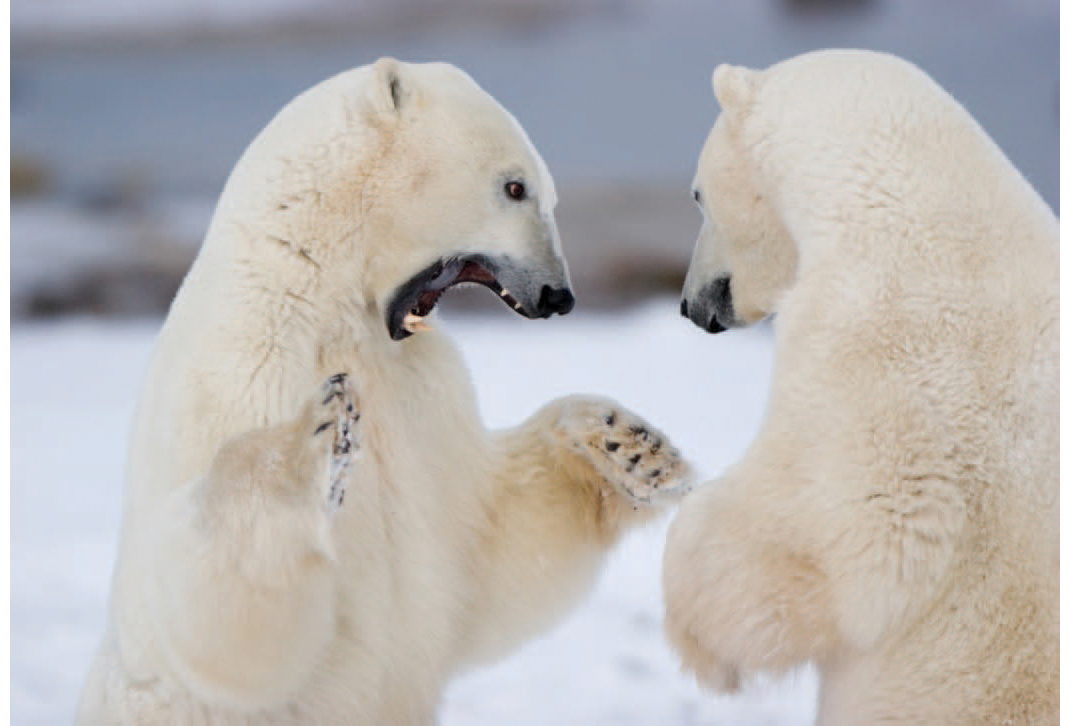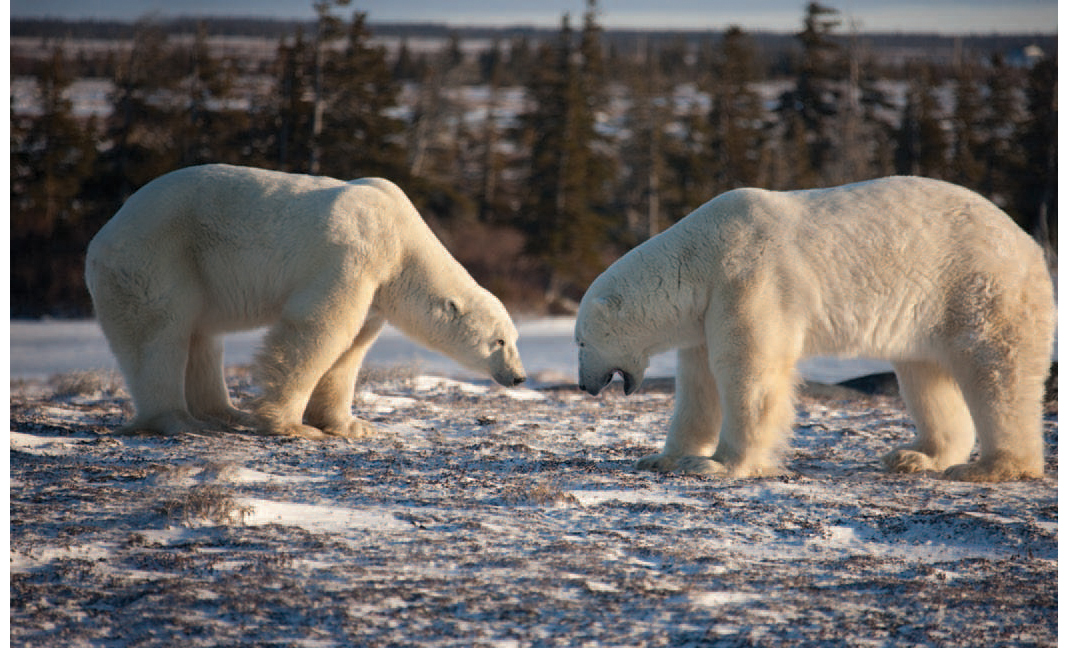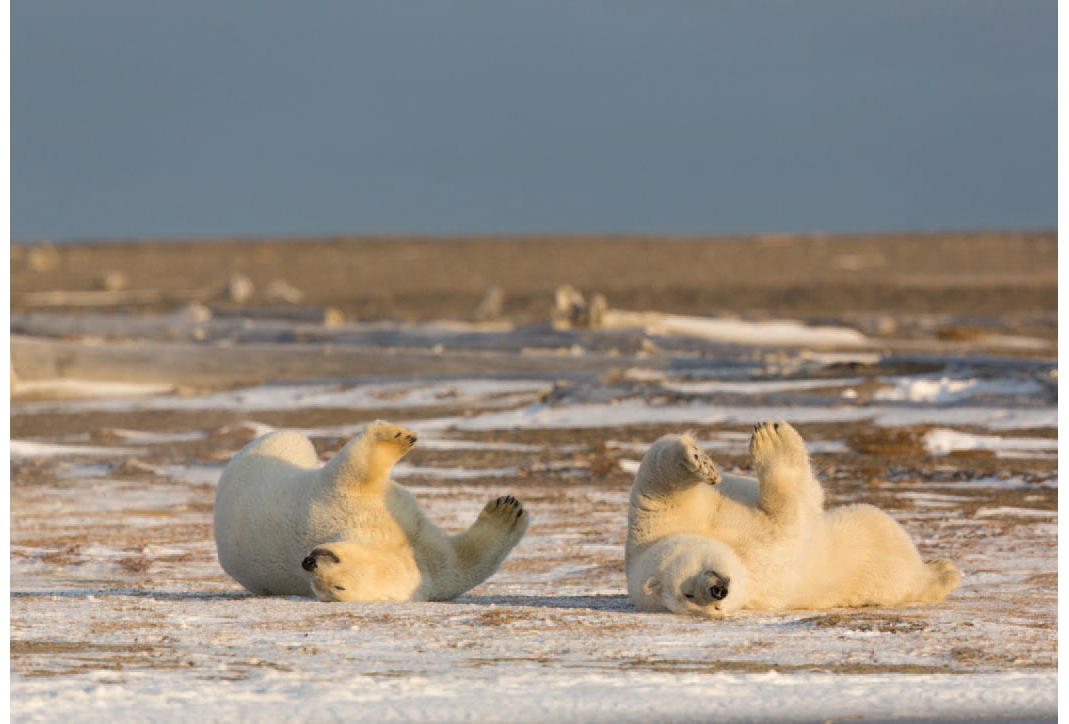Although the Polar Bear is considered a solitary species, one where only a mother and cubs or the temporary liaison of a mating couple relieve this lonely existence, Polar Bears can be both social and quite playful when conditions draw bears together. At whale carcasses, where a dozen or more Polar Bears may congregate to feed, bears do so amiably, secure perhaps in the knowledge that there is enough for all. In the vicinity of Churchill, Manitoba, Canada, where hundreds of Polar Bears gather or pass by as they await Hudson Bay’s freeze-up, young male bears may spend hours playfully wrestling with one another. Cubs, either with each other or, sometimes, with their tolerant mother, spend much of their day at play, sometimes spoiling their mother’s hunt for seals by doing so.
Play activity is common among predators, even such solitary creatures as the Polar Bear. In some, this playfulness is only exhibited during courtship, when normally staid creatures appear to act foolishly, perhaps liberating their souls, if I can call it that, in these moments of interaction. Sometimes the weather triggers playful behavior. I’ve seen full-grown male African Lions rear up on their hind legs, boxing with one another, their claws sheathed inside their paws and their deadly fangs purposefully hidden in a display of non-aggression, just after a soaking rainstorm. African Wild Dogs and Asiatic Dholes, or Indian Wild Dogs, foxes and coyotes, all will box and mouth and hop over one another in play, sometimes for minutes on end.
Herbivores play as well, and you’ll witness this activity if you’re in the field long enough. Young zebras and gnus, still amazed perhaps at the liberating abilities of their long legs, race in circles around their mothers or chase one another across the grasslands. Gray Squirrels in your backyard seem to play tag, chasing one another up and down tree trunks, and even birds play, as Swallows drop a feather and snatch it in mid-air repeatedly.
For the Polar Bear, play no doubt relieves the tedium of waiting for the ice to return and may also serve to help define a bear’s status and strength within its population. A friendly bout will, nonetheless, provide clues as to each contestant’s strength, establishing a dominance hierarchy that may forestall a more serious encounter later on. By the act of playing, Polar Bears may lessen the chance of injury through unnecessary contests over food or mates, when any wound could lessen a bear’s ability to survive. Play, then, may not only be fun, it may be a great strategy for survival.
HARMLESS PLAY
Photos: Tom Wester
In Churchill, Manitoba, subadult male Polar Bears frequently wrestle as the air chills and Hudson Bay’s freeze-up becomes imminent. Some encounters, like this one, look downright playful, while others, to the untrained eye, appear to be serious fights.


ESTABLISHING DOMINANCE

Photo, above: Tom Wester
Photo, bottom: Hugh Rose/hughrosephotography.com
While most of the wrestling matches involve subadult males, adult males may engage in contests as well. Although this may be a form of play to relieve boredom, these matches also help to establish a pecking order where bears learn who is the strongest and most aggressive in situations that are not serious or life-threatening. Only rarely does a session get serious and injuries result.


GENTLE MOUTHS
Photo: Richard Day
Carnivores at play, be that a wolf, African Lion, or Polar Bear, convey their harmless intentions by not revealing their sharp and dangerous canine teeth, or fangs. Typically, the animal’s muzzle covers these fangs, lessening the chance of inflicting accidental injury.

PINNED!
Wrestling matches can go on for hours, often with one opponent on top for a few minutes, and then flat on his back the next. Matches that get rough are sometimes ended by a bear grabbing his opponent’s neck and forcing submission. This technique is also employed in disputes over kills, triggering a submissive posture in the weaker bear. This behavior is seen in a variety of predators, including your family dog!

WATER GAMES
Photo: Hugh Rose/hughrosephotography.com
Two subadult Polar Bears played for hours in small pools formed in the developing fast ice. A layer of fat and a dense underfur two inches thick overlaid by thicker guard hairs that may be six inches long insulate these bears from the cold and wet.

SLIDES
On the hill and mountain slopes in Svalbard, you might see long ribbons of disturbed snow where a Polar Bear slid on its belly downhill. Bears apparently do this for fun, as tracks sometimes lead back up the hill where the process is repeated.

IDLE THREAT
Photo: Tom Wester
While these two subadult Polar Bear males were just playing, their posture resembles that of two bears that might square off in a more serious altercation. In what is known as a displacement activity, bears will yawn, just as a bull moose may paw the ground. Bears may step sideways and rear up high, showing off their size in a further effort to intimidate their rival.

SYNCHRONIZED ROLLING
Photo: Hugh Rose/hughrosephotography.com
For several minutes, these two subadult bears, possibly siblings, rolled and stretched in near-perfect synchrony, much to the delight of the tourists photographing them nearby.
